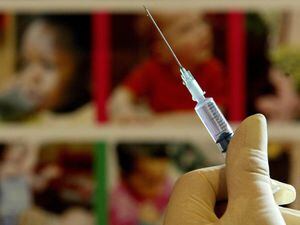MMR vaccine uptake increases for the first time in six years
NHS Digital data showed one in 10 children aged two are still unvaccinated against measles, mumps and rubella.

The proportion of children having their first dose of the measles, mumps and rubella (MMR) jab has increased for the first time in six years.
New data from NHS Digital shows that, while coverage is still below the 95% needed for herd immunity, the proportion having the first dose of the vaccine by age two has risen from 90.3% in 2018/19 to 90.6% in 2019/20.
This is the first time in six years that MMR coverage in England has increased, following a peak of 92.7% in 2013/14.
Dr Andrew Wakefield’s 1998 Lancet study caused vaccination rates to plummet, resulting in a rise in measles.
The findings were later discredited and the General Medical Council (GMC) struck him off, ruling he had been “dishonest, irresponsible and showed callous disregard for the distress and pain” of children.

Regional data shows an increase in coverage in six of the nine English regions in 2019/20 compared with the previous year.
Coverage fell in the remaining three regions, NHS Digital said.
The North East had the highest level of coverage at 95.1% and was the only region to exceed the national target of 95%.
London had the lowest level of coverage at 83.6%, but this was up from 83% the previous year.
Across England, 94.5% of children aged five had received the first dose of the MMR vaccine in 2019/20 – the same percentage as the previous year.
In 2019/20, eight out of nine regions achieved 95% coverage.
When it comes to other vaccines, coverage aged two for the combined jab to protect against diseases including diphtheria, pertussis, tetanus and polio was below the 95% target for the second consecutive year.
But aged one, coverage was up slightly and was up again by age five.
For the meningitis B jab, England coverage at the age of 24 months was 88.7% in 2019/20 – up from 87.8% in 2018/19.
Dr Nikki Kanani, GP and NHS national director of primary care, said: “Vaccines provide vital protection against life-threatening diseases and so it is great that coverage of MMR is increasing, but we want even more parents to come forward and get their children vaccinated.
“NHS staff are working hard to ensure that MMR and other vital vaccination appointments are still going ahead safely throughout the pandemic, so as a mum and a GP I want to remind other parents that getting your kids their vaccination is not only safe, but potentially life-saving.”
Dr Doug Brown, chief executive of the British Society for Immunology, welcomed the “small increase in uptake for most routine vaccinations” but said “none of them have reached the necessary uptake level of 95% at the correct timepoint.”
He added: “The slight rise in uptake of routine childhood vaccinations in England is a step in the right direction but we must still take urgent action to overcome the ongoing trend of missing the 95% target set out by the World Health Organisation.
“Low levels of vaccination coverage matter as it means diseases such as measles have the potential to spread within our communities, infecting unvaccinated people, including vulnerable individuals unable to have vaccinations such as young babies or people with cancer.”





